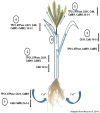Calcium Biofortification: Three Pronged Molecular Approaches for Dissecting Complex Trait of Calcium Nutrition in Finger Millet (Eleusine coracana) for Devising Strategies of Enrichment of Food Crops
- PMID: 28144246
- PMCID: PMC5239788
- DOI: 10.3389/fpls.2016.02028
Calcium Biofortification: Three Pronged Molecular Approaches for Dissecting Complex Trait of Calcium Nutrition in Finger Millet (Eleusine coracana) for Devising Strategies of Enrichment of Food Crops
Abstract
Calcium is an essential macronutrient for plants and animals and plays an indispensable role in structure and signaling. Low dietary intake of calcium in humans has been epidemiologically linked to various diseases which can have serious health consequences over time. Major staple food-grains are poor source of calcium, however, finger millet [Eleusine coracana (L.) Gaertn.], an orphan crop has an immense potential as a nutritional security crop due to its exceptionally high calcium content. Understanding the existing genetic variation as well as molecular mechanisms underlying the uptake, transport, accumulation of calcium ions (Ca2+) in grains is of utmost importance for development of calcium bio-fortified crops. In this review, we have discussed molecular mechanisms involved in calcium accumulation and transport thoroughly, emphasized the role of molecular breeding, functional genomics and transgenic approaches to understand the intricate mechanism of calcium nutrition in finger millet. The objective is to provide a comprehensive up to date account of molecular mechanisms regulating calcium nutrition and highlight the significance of bio-fortification through identification of potential candidate genes and regulatory elements from finger millet to alleviate calcium malnutrition. Hence, finger millet could be used as a model system for explaining the mechanism of elevated calcium (Ca2+) accumulation in its grains and could pave way for development of nutraceuticals or designer crops.
Keywords: bioavailability; biofortification; calcium; finger millet; functional genomics; molecular breeding; transgenics.
Figures






Similar articles
-
Nutraceutical Value of Finger Millet [Eleusine coracana (L.) Gaertn.], and Their Improvement Using Omics Approaches.Front Plant Sci. 2016 Jun 29;7:934. doi: 10.3389/fpls.2016.00934. eCollection 2016. Front Plant Sci. 2016. PMID: 27446162 Free PMC article. Review.
-
Harnessing Finger Millet to Combat Calcium Deficiency in Humans: Challenges and Prospects.Front Plant Sci. 2017 Jul 26;8:1311. doi: 10.3389/fpls.2017.01311. eCollection 2017. Front Plant Sci. 2017. PMID: 28798761 Free PMC article. Review.
-
Gene Discovery and Advances in Finger Millet [Eleusine coracana (L.) Gaertn.] Genomics-An Important Nutri-Cereal of Future.Front Plant Sci. 2016 Nov 9;7:1634. doi: 10.3389/fpls.2016.01634. eCollection 2016. Front Plant Sci. 2016. PMID: 27881984 Free PMC article. Review.
-
Finger millet (Eleusine coracana L.): from staple to superfood-a comprehensive review on nutritional, bioactive, industrial, and climate resilience potential.Planta. 2024 Aug 17;260(3):75. doi: 10.1007/s00425-024-04502-2. Planta. 2024. PMID: 39153062 Free PMC article. Review.
-
Genome and Transcriptome sequence of Finger millet (Eleusine coracana (L.) Gaertn.) provides insights into drought tolerance and nutraceutical properties.BMC Genomics. 2017 Jun 15;18(1):465. doi: 10.1186/s12864-017-3850-z. BMC Genomics. 2017. PMID: 28619070 Free PMC article.
Cited by
-
Mainstreaming orphan millets for advancing climate smart agriculture to secure nutrition and health.Front Plant Sci. 2022 Aug 12;13:902536. doi: 10.3389/fpls.2022.902536. eCollection 2022. Front Plant Sci. 2022. PMID: 36035707 Free PMC article.
-
Microbial-assisted and genomic-assisted breeding: a two way approach for the improvement of nutritional quality traits in agricultural crops.3 Biotech. 2020 Jan;10(1):2. doi: 10.1007/s13205-019-1994-z. Epub 2019 Nov 26. 3 Biotech. 2020. PMID: 31824813 Free PMC article. Review.
-
Genome-wide association study reveals the genetic variation and candidate gene for grain calcium content in bread wheat.Plant Cell Rep. 2023 Aug;42(8):1379-1390. doi: 10.1007/s00299-023-03036-3. Epub 2023 May 25. Plant Cell Rep. 2023. PMID: 37227494
-
Genome-Wide Association Study of Calcium Accumulation in Grains of European Wheat Cultivars.Front Plant Sci. 2017 Oct 27;8:1797. doi: 10.3389/fpls.2017.01797. eCollection 2017. Front Plant Sci. 2017. PMID: 29163559 Free PMC article.
-
Genome-wide association study reveals the genetic architecture for calcium accumulation in grains of hexaploid wheat (Triticum aestivum L.).BMC Plant Biol. 2022 May 4;22(1):229. doi: 10.1186/s12870-022-03602-z. BMC Plant Biol. 2022. PMID: 35508960 Free PMC article.
References
-
- Admassu S., Teamir M., Alemu D. (2009). Chemical composition of local and improved finger millet (Eleusine coracana (L.) Gaetrtin) varieties grown in Ethiopia. Ethiop. J. Health Sci. 19 1–8.
-
- Anonymous (1996). European Pharmacopoeia 3rd Edn. Strasburg: Council of Europe; 121–122.
Publication types
LinkOut - more resources
Full Text Sources
Other Literature Sources
Miscellaneous

